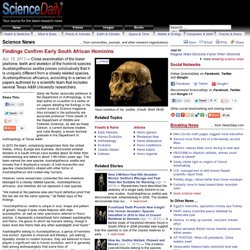

Artifacts Of Unknown Origin - Messengers From Space? MessageToEagle.com - Ancient past on Earth was definitely a world of higher science, complex machines, electricity and metallurgy.

A strange metal object of unknown origin was found in the inside of a geode - a natural mineral that as we know, requires millions of years to be formed. It is mostly unusual to find a piece of metal which is both polished and manufactured, inside a geode. The geodes are hollow rocks that contain crystalline structures in their interiors, but certainly not metal fragments. In a very distant past, someone placed this metal object inside the geode. The stone is one of the most valuable in China and in the world. Startling Discovery Of Frozen Caveman In Himalayan Mountain. MessageToEagle.com - During an expedition to the Himalayan Mountains a group of Swedish and Norwegian climbers made a startling discovery.

Inside one of the caverns that seem to have recently surfaced after a series of violent avalanches in the region, they found a frozen body of a humanoid from the Paleolithic era. Primary analysis of the skeleton reveal the bones belong to an adult male Homo habilis, which is believed to have lived from approximately 2.33 to 1.44 million years ago, during the Gelasian Pleistocene period. Others seem to believe that the man was part of a small group that long-outlived the extinction of the majority of his species.
Whatever the results of the carbon dating test, this opens a whole new interpretation of generally accepted views of the colonization of the planet by the human species. According to most widely accepted theories on the subject, Homo habilis isn't normally believed to have traveled this far from Africa and lived in such hostile climates. THE MOON, an alien UFO base, a satellite that doesn't belong to us... 10 Million 500 000 Year. Les pierres d'Ica. A la mémoire du Dr Javier Cabrera Darquea ... 1) La première curiosité des pierres d'Ica réside dans l'emplacement même où ces pierres ont été trouvées.

En venant de la mer, ou en longeant les côtes péruviennes, lorsque vous voyez le "Chandelier des Andes", vous suivez la direction qu'il indique vers les fameuses lignes de Nazca et vous survolerez Ica, petite ville à 360 kilomètres au sud de Lima. C'est une région désertique, parmi les plus anciennes du globe, où l'on peut voir de nombreux restes pétrifiés d'animaux affleurant à la surface. Le sous-sol contient de nombreuses tombes incas et pré-incaïques. 2) La deuxième curiosité, est la manière dont ces pierres ont été déclarées fausses. Les premières pierres sont rassemblées au début des années 60 par Carlos et Pablo Soldi. The Mysterious Ica Stones Of Peru. REINCARNATION PREUVES : DONT L'ENFANT MARTIEN. (Tous droits réservés) Voici un cas de réincarnation extraordinaire et tout à fait hors du commun, que je vous rapporte en résumé, où l'écrivain nous présente une quasi-preuve de la Réincarnation.

Indigo Boy from Mars. Edgar Cayce. Edgar Cayce. Un article de Wikipédia, l'encyclopédie libre.

Edgar Cayce. En octobre 1910, cette photographie volée au domicile des parents de Cayce par un journaliste paraît à la une du New York Times sous le titre: « Illiterate Man Becomes a Doctor When Hypnotized » (« Sous hypnose, un illettré se transforme en médecin »). Edgar Cayce. Edgar Cayce (/ˈkeɪsiː/; March 18, 1877 – January 3, 1945) was an American psychic who allegedly possessed the ability to answer questions on subjects as varied as healing, reincarnation, wars, Atlantis and future events while in a trance.

These answers came to be known as "life readings of the entity" and were usually delivered to individuals while Cayce was hypnotized. This ability gave him the nickname "The Sleeping Prophet". ORIGINE EXTRATERRESTRE DE L’HOMME. (Tous droits réservés) L’Homme n’est pas né sur Terre, il vient des étoiles, sous une forme inattendue...

C'est l'une des plus extraordinaires "informations", que prônait Edgar Cayce dans ses "lectures" sur l'origine de l'Humanité, qui sont conservées dans une chambre-forte à Virginia Beach, Virginie. Comme j'ai des raisons de croire une grande partie de ce que Cayce a pu dire (sous auto-hypnose) je vais apporter dans cet article des "présomptions de preuves" et divers éléments qui ont tendance à démontrer que Cayce a vraisemblablement dit la vérité sur notre étrange origine (en fait, au moins la seconde, sinon plus...).
Ainsi, si l'on en croit Cayce, des entités venant du lointain Cosmos sont arrivées sur la Terre il y a 10 millions 500 000 ans et se sont créés des corps humains à peu près à notre image. 2,8 Million Year. Controversial And Out-Of-Place In Time: Metallic Spheres From South Africa - MessageToEagle.com. MessageToEagle.com - These artifacts are very controversial because they appear to be much too advanced for their time.

Approximately 200 metallic spheres in size from 2.2 to 10 cm, were found in a silver mine in the eastern Transvaal Ottosoal, South Africa. They are at least 2.8 billion years old and simply do not fit into any conventional prehistoric time-scale. No one knows the purpose, for which they were manufactured, and most of all - who created them. "Over the past several decades, South African miners have found hundreds of metallic spheres, at least one of which has three parallel grooves running around its equator," Michael Cremo wrote in his great book "The Hidden History Of The Human Race".
According to an article by J. "The spheres are a complete mystery. "One problem with the hypothesis is that the objects are limonite concretions concerns their hardness... 2,6 Million Year. Findings confirm early South African hominins. Apr. 15, 2013 — Close examination of the lower jawbone, teeth and skeleton of the hominid species Australopithecus sediba proves conclusively that it is uniquely different from a closely related species, Australopithecus africanus , according to a series of papers authored by a scientific team that includes several Texas A&M University researchers.

Darryl de Ruiter, associate professor in the Department of Anthropology, is the lead author or co-author in a series of six papers detailing the findings in the current issue of Science magazine. Surprise Human-Ancestor Find—Key Fossils Hidden in Lab Rock. Last month a prehistoric tooth protruding from a boulder tipped off researchers to hidden evolutionary treasure: remarkably complete human-ancestor fossils trapped in a rock that had been sitting in their lab for years. Scans later showed that the rock contains two-million-year-old fossils that will "almost certainly" make one Australopithecus sediba specimen "the most complete early human ancestor skeleton ever discovered," anthropologist Lee Berger said in a statement Thursday. (See pictures of Australopithecus sediba fossils.) The bones are nearly invisible from the outside, and were discovered only after a technician noticed the small tooth in the three-foot-wide (meter-wide) rock, which was retrieved from a South African cave in 2008 and brought to a lab at the University of the Witwatersrand in Johannesburg.
The tooth turned out to be just the tip of the fossil iceberg. (Recent A. "The More Bones, the Better" Oldest fossil hominin ear bones ever recovered: Discovery could yield important clues on human origins. May 13, 2013 — A new study, led by a Binghamton University anthropologist and published this week by the Proceedings of the National Academy of Sciences , could shed new light on the earliest existence of humans.

The study analyzed the tiny ear bones, the malleus, incus and stapes, from two species of early human ancestor in South Africa. The ear ossicles are the smallest bones in the human body and are among the rarest of human fossils recovered. Unlike other bones of the skeleton, the ossicles are already fully formed and adult-sized at birth. This indicates that their size and shape is under very strong genetic control and, despite their small size, they hold a wealth of evolutionary information.
The study, led by Binghamton University anthropologist Rolf Quam, was carried out by an international team of researchers from institutions in the US, Italy and Spain. The researchers report several significant findings from the study. The Nampa figurine. The figurine from Nampa (Idaho, USA) A small clay figurine of a human was found in 1889 at Nampa, Idaho. It came from a well boring, at a depth of around 90 metres, where the clay geological stratum of the Glenns Ferry Formation dates to the Pliocene-Pleistocene transition, around 2 million years ago.
This stratum is sealed by a basalt layer. It is about 37 mm long and appears to be a representation of a clothed woman. The surface had concretions of iron and patches of anhydrous red oxide. The difficulties with an object of this nature are immense. There are numerous mechanisms by which the figurine could have worked its way into the Pliocene-Pleistocene clay (through fissures, through mining activity and so on). Neandertals' Speech and Language Similar To Our Modern Languages. Get our top stories Follow MessageToEagle.com Subscribe in a reader Other Popular Articles Do We Live In A Computer Simulation Created By An Advanced Alien Civilization? The captivating idea that we might be living in 3 dimensional holographic simulation has been put forward by various scientists. We will explore this mind-boggling idea further and examine some intriguing questions. Ancient skeletons discovered in Georgia threaten to overturn the theory of human evolution. By David Derbyshire Updated: 12:26 GMT, 9 September 2009 For generations, scientists have believed Africa was the cradle of mankind.
D'étranges dents d'hominidés : la nouvelle pièce du puzzle de l'évolution humaine. HOMINIDÉS.